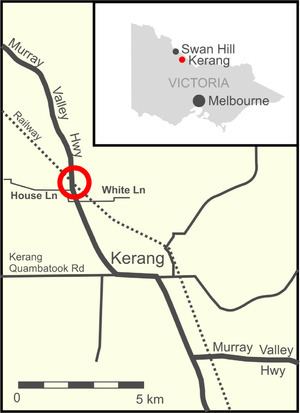Time 13:40 Passengers 36 Location Kerang, Australia Operator V/Line Passenger count 36 | Country Australia Cause Truck driver error Date 5 June 2007 Total number of deaths 11 Injuries 23 Trains 1 | |
 | ||
Type of incident Level crossing collision | ||
The Kerang train accident occurred on 5 June 2007 at about 13:40 AEST in the Australian state of Victoria, approximately 6 kilometres (3.7 mi) north of the town of Kerang in the state's northwest, and 257 kilometres (160 mi) north-northwest of the city of Melbourne.
Contents
Southbound V/Line passenger train service 8042, which consisted of locomotive N460 and carriage set N7, was run into by a northbound semi-trailer truck, at a level crossing where the Piangil railway line crosses the Murray Valley Highway. The locomotive and first carriage escaped impact as the truck swerved left. However, the second carriage and third carriages were both struck, causing severe damage to the carriages and fatal injury to 11 passengers.
Given that the truck had a mass of about 40 tonnes, and had been travelling at 100 km/h, its impact was devastating. The truck, owned by the Canny Carrying Company of Wangaratta and driven by Christiaan Scholl, was extensively damaged on impact with the carriages, although Scholl only sustained shoulder and head injuries.
Victoria Police confirmed that 11 people were killed and 23 injured in the crash, making this to date the deadliest Australian rail disaster since 1977. As of 11:00 am on 6 June, two passengers remained unaccounted for. The site was visited on the evening of 5 June by the Premier of Victoria, Steve Bracks, who called it a "horrific scene".
The train involved in the accident was a locomotive-hauled service from Swan Hill that departed for Melbourne at 13:00, operated by an N class locomotive and three car N type carriage set. The collision caused the closure of nearby sections of the Murray Valley Highway.
Response
Emergency response was swift, with a number of seriously injured people airlifted to Melbourne, while others were taken by road or air ambulance to nearby Kerang Hospital. The State Premier Steve Bracks flew to the crash scene on the evening of 5 June with the Victoria Police Assistant Commissioner Noel Ashby and the Opposition transport spokesman Terry Mulder, calling it a "horrific scene".
Both the Federal Minister for Transport and Regional Services Mark Vaile and the Prime Minister John Howard spoke to the media, offering Federal government aid to families as well as the investigative assistance of the Australian Transport Safety Bureau. Leader of the Opposition Kevin Rudd said that he was "saddened and shocked" by the incident and went on to say that his "thoughts and prayers tonight are with those still fighting for their life in hospitals throughout Victoria."
V/Line announced it would support a full inquiry and had arranged counselling for the passengers and their families. Chief executive Rob Barnett said the incident would raise questions about the safety of level crossings, but asked everyone to resist jumping to conclusions. Buses replaced trains between Bendigo and Swan Hill until the crash site was cleared and the site released by accident investigators.
Due to the nature of land surrounding the accident site, some earthworks were required to provide a solid footing for the heavy lifting equipment needed to remove the rolling stock damaged in the accident. Once removed from the line, the damaged rolling stock was transported to Melbourne for further investigation, with some of the carriages still in storage in 2008.
The driver of the semi-trailer, Christiaan Scholl, was charged with one count of culpable driving and on 7 June was bailed to appear before Bendigo Magistrates Court on 19 December. A police spokesman stated that more charges were expected to be laid in due course. On 18 August 2008, Scholl was committed for trial on 11 charges of causing death by culpable driving and 8 charges of causing injury by negligent driving. His trial began in Bendigo on 26 May 2009. On 13 June 2009, he was found not guilty on all charges. A group of crash victims indicated they would pursue a civil action against Scholl.
Incident
One survivor recalled, "A lady sitting across from me saw the truck and closed her eyes. You just wonder how anybody got out."
Ursula McGuinnes, general manager of Stakeholder Relations for V/Line, noted that the level crossing was protected with lights and bells, which were still sounding and flashing when emergency services arrived, but did not have boom gates.
According to Kerang resident and Shire of Gannawarra councillor Lui Basile, there had been a recent timetable change on the line.
On 15 February 2008, the Office of the Chief Investigator, Department of Infrastructure, released Rail Safety Report 2007/09, detailing the findings of the investigation into the collision. The report noted that the train, truck, and level crossing warning signals were all serviceable prior to the incident, and both the train and truck driver were familiar with their respective routes. The report noted that the truck driver did not agree to be interviewed by investigators, and concluded that: "For reasons not determined the truck driver did not respond in an adequate time and manner to the level crossing warning devices."
Inquest
An inquiry into the Kerang rail disaster was due to begin on 18 January 2011, but was delayed by a day due to flooding in the region. The inquest began on 19 January at the Coroner's Court in Bendigo. After a minute's silence, coroner Dr Jane Hendtlass heard evidence from the driver of the train. The inquest was scheduled to run over 58 days.
